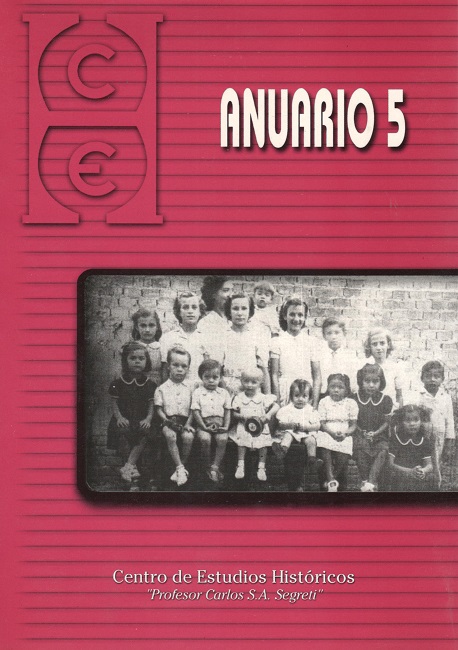At the beginning of the entrepreneurial State: public investment in railways and sanitary works between 1900 and 1928
DOI:
https://doi.org/10.52885/2683-9164.v.n5.23245Keywords:
State, public enterprise, railways, water and drainage worksAbstract
Between 1900 and 1928, the Argentine economy experienced important changes. Strongly specialized at first in the exportation of primary goods to European markets, the economy gradually turned to import substitution for the internal market. In the meantime, there was an uninterrupted growth in size and the functions performed by the State. In this paper we approach this evolution with an analysis of public investments by the National Government, in two critical areas for that period: railways and water and drainage works, both of which resulted in the formation of the first autonomous national public entities and marked de beginnings of the public enterprise in the twentieth century Argentina. We pretend to contribute, from a public finance approach, to the understanding of the conditions of emergence of the new Entrepreneur State, in a period of important changes in the political and the economic side.
Downloads
References
BORDI Olga de RAGUCCI, El Agua privada en Buenos Aires, 1856-1892, Instituto Histórico de la Ciudad de Buenos Aires, Buenos Aires, 1997.
BOUVIER Jean, “Histoire financiére et problémes d analyse des dépenses publiques”, Annales E.S.C, 33: 2, 1978.
CORTÉS CONDE Roberto, Dinero, deuda y crisis. Evolución fiscal y monetaria en la Argentina, Buenos Aires, Sudamericana, 1994.
DÍAZ FUENTES Daniel, Crisis y cambios estructurales en América Latina. Argentina, Brasil y México durante el período de entreguerras, México, FCE, 1994.
FERNS H.S, Gran Bretaña y Argentina en el siglo XIX, Buenos Aires, Solar-Harchette, 1960.
LACOSTE Pablo, El Ferrocarril Trasandino, 1827-1984, Santiago de Chile, Editorial Universitaria y Centro de Investigaciones Diego Barros Arana, 2000.
LOPEZ Justo (h), Historia de los ferrocarriles nacionales, Buenos Aires, Lumiére, 1994.
MARICHAL Carlos, Historia de la deuda externa de América Latina, Madrid, Alianza, 1988.
MARICHAL Carlos, “Políticas de desarrollo económico y deuda externo en Argentino (1868-1880)”, Siglo XIX, Revista de Historia, México, III: 5, 1988.
PALERMO Silvana A., “The Nation Building Mission: The State-Owned Railways in Modern Argentina (1870-1930)”,Ph. Diss, State University of New York at Stony Brook, 2001.
REY Osvaldo, El saneamiento en el área metropolitana, Buenos Aires, Aguas Argentinas, 2000.
OSZLAK Oscar, La formación del Estado Argentino, Buenos Aires, Editorial de Belgrano, 1982.
REGALSKY Andrés y SALERNO Elena, “Las finanzas públicas argentinas en tiempos del radicalismo: ferrocarriles, obras públicas y endeudamiento, 1916-1928”, Terceras Jornadas de Historia Económica, Asociación Uruguaya de Historia Económica, Montevideo, 2003.
REGALSKY Andrés M., Menudos, inversores y élites: las inversiones francesas en la Argentina, 1880-1914, Buenos Aires, Editorial de la Universidad Nacional de Tres de Febrero, 2002.
SALERNO Elena, Los comienzos del Estado empresario: La Administración General de los Ferrocarriles del Estado (1910-1928), Centro de Estudios Económicos de la Empresa y el Desarrollo (CEEED), Instituto de Investigaciones Económicas, Facultad de Ciencias Económicas, Universidad de Buenos Aires, Documento de Trabajo núm. 6, Buenos Aires, 2003.
Downloads
Published
Issue
Section
License
Aquellos autores/as que tengan publicaciones con esta revista, aceptan los términos siguientes:
- Los autores/as conservarán sus derechos de autor y garantizarán a la revista el derecho de primera publicación de su obra, el cuál estará simultáneamente sujeto a una Licencia de reconocimiento de Creative Commons. Se puede compartir, copiar, distribuir, ejecutar y comunicar públicamente la obra, siempre que: a) se cite la autoría y la fuente original de su publicación (revista, editorial y URL de la obra); b) no se use para fines comerciales; c) no se altere, transforme o genere una obra derivada a partir de esta obra.
- Los autores/as podrán adoptar otros acuerdos de licencia no exclusiva de distribución de la versión de la obra publicada (p. ej.: depositarla en un archivo telemático institucional o publicarla en un volumen monográfico) siempre que se indique la publicación inicial en esta revista.
- Se permite y recomienda a los autores/as difundir su obra a través de Internet (p. ej.: en archivos telemáticos institucionales o en su página web) después del proceso de publicación, lo cual puede producir intercambios interesantes y aumentar las citas de la obra publicada. (Véase El efecto del acceso abierto).









